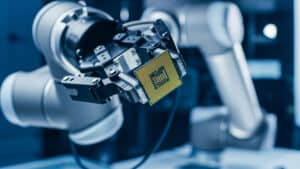
The new robots leverage modern mobility standards, and both the platform and arm are rated cleanroom class ISO 3.
Demand is still high for semiconductor chips. As companies scramble for to overcome the current chip shortage they need for their products and consumers get restless with extended wait times, chip manufacturers have turned to novel solutions. KUKA has revealed a new robot designed to ease the manufacturing shortage through a new automated assembly solution.
The new robot, revealed during a SEMICON showcase, reliably transfers materials for chips in areas where the traditional robotic solution hasn’t been well suited to the installment location. The wafer handling system works well with human collaboration. It will offer services like material transport of 200mm or 300mm wafer boxes and SMIF boxes, as well as open cassette machine loading and unloading.
The machine features no external cabling and a flexible arm designed for compact spaces. An omnidirectional wheel on the platform itself also increases movement capabilities. This reduces the installation space requirements and will allow manufacturers to increase the number of machines available or install in spaces where traditional expansion would not be possible.
It’s also completely integrated. There is one controller and a single software solution for the robot itself, the platform, and navigation. This reduces barriers to immediate use.
See also: Global Chip Shortage Will Persist
Solving the chip shortage one piece of technology at a time
Chip manufacturers have been searching for new solutions to the chip shortage. With materials and the supply chain out of their control, they’ve turned to the one thing they do control—more efficient manufacturing methods. These types of robotics will allow more machines to fit into a space or revitalize unused sections of the factory.
The robots leverage new mobility standards, and both the platform and arm are rated cleanroom class ISO 3. With enhanced safety and navigational features, including laser scanning and safety warning/safety stop fields, they’re expected to be an excellent addition to chip factories as they push the boundaries of production.




























